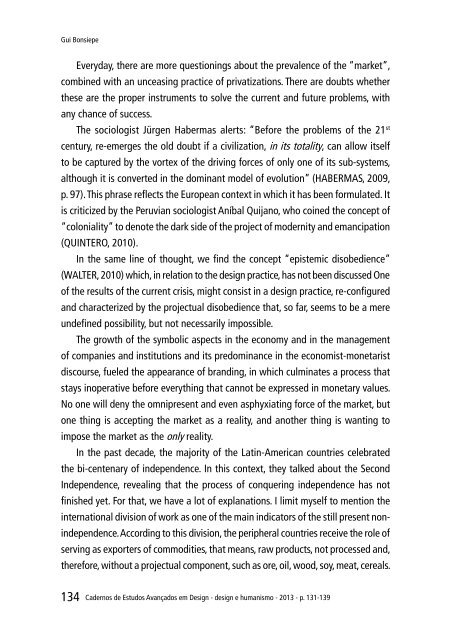o_19po8js951tvs1r0t1r8s4bb1vpla.pdf
Create successful ePaper yourself
Turn your PDF publications into a flip-book with our unique Google optimized e-Paper software.
Gui Bonsiepe<br />
Everyday, there are more questionings about the prevalence of the “market”,<br />
combined with an unceasing practice of privatizations. There are doubts whether<br />
these are the proper instruments to solve the current and future problems, with<br />
any chance of success.<br />
The sociologist Jürgen Habermas alerts: “Before the problems of the 21 st<br />
century, re-emerges the old doubt if a civilization, in its totality, can allow itself<br />
to be captured by the vortex of the driving forces of only one of its sub-systems,<br />
although it is converted in the dominant model of evolution” (HABERMAS, 2009,<br />
p. 97). This phrase reflects the European context in which it has been formulated. It<br />
is criticized by the Peruvian sociologist Aníbal Quijano, who coined the concept of<br />
“coloniality” to denote the dark side of the project of modernity and emancipation<br />
(QUINTERO, 2010).<br />
In the same line of thought, we find the concept “epistemic disobedience”<br />
(WALTER, 2010) which, in relation to the design practice, has not been discussed One<br />
of the results of the current crisis, might consist in a design practice, re-configured<br />
and characterized by the projectual disobedience that, so far, seems to be a mere<br />
undefined possibility, but not necessarily impossible.<br />
The growth of the symbolic aspects in the economy and in the management<br />
of companies and institutions and its predominance in the economist-monetarist<br />
discourse, fueled the appearance of branding, in which culminates a process that<br />
stays inoperative before everything that cannot be expressed in monetary values.<br />
No one will deny the omnipresent and even asphyxiating force of the market, but<br />
one thing is accepting the market as a reality, and another thing is wanting to<br />
impose the market as the only reality.<br />
In the past decade, the majority of the Latin-American countries celebrated<br />
the bi-centenary of independence. In this context, they talked about the Second<br />
Independence, revealing that the process of conquering independence has not<br />
finished yet. For that, we have a lot of explanations. I limit myself to mention the<br />
international division of work as one of the main indicators of the still present nonindependence.<br />
According to this division, the peripheral countries receive the role of<br />
serving as exporters of commodities, that means, raw products, not processed and,<br />
therefore, without a projectual component, such as ore, oil, wood, soy, meat, cereals.<br />
134<br />
Cadernos de Estudos Avançados em Design - design e humanismo - 2013 - p. 131-139



